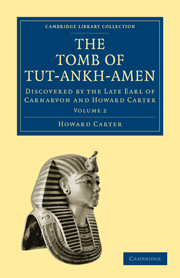Book contents
- Frontmatter
- PREFACE
- Contents
- LIST OF PLATES
- INTRODUCTION. REMARKS UPON EGYPTIAN ART
- CHAPTER 1 TUT-ANKH-AMEN
- CHAPTER 2 THE TOMB AND BURIAL CHAMBER
- CHAPTER 3 CLEARING THE BURIAL CHAMBER AND OPENING THE SARCOPHAGUS
- CHAPTER 4 THE STATE CHARIOTS
- CHAPTER 5 THE OPENING OF THE THREE COFFINS (SEASON 1925–26)
- CHAPTER 6 POINTS OF INTEREST IN EGYPTIAN BURIAL CUSTOMS
- CHAPTER 7 THE EXAMINATION OF THE ROYAL MUMMY
- APPENDICES
- APPENDIX I REPORT UPON THE EXAMINATION OF TUT-ANKH-AMEN'S MUMMY
- APPENDIX II THE CHEMISTRY OF THE TOMB
- APPENDIX III REPORT ON THE FLORAL WREATHS FOUND IN THE COFFINS OF TUT-ANKH-AMEN
- APPENDIX IV NOTES ON OBJECTS FROM THE TOMB
- APPENDIX V REPORT ON THE EXAMINATION OF SPECIMENS FROM THE TOMB OF KING TUT-ANKH-AMEN
- APPENDIX VI DESCRIPTION OF THE OBJECTS. PLATES XXXVII-LXXXVIII
- INDEX
- Plate section
- Plate section
APPENDIX III - REPORT ON THE FLORAL WREATHS FOUND IN THE COFFINS OF TUT-ANKH-AMEN
Published online by Cambridge University Press: 05 March 2012
- Frontmatter
- PREFACE
- Contents
- LIST OF PLATES
- INTRODUCTION. REMARKS UPON EGYPTIAN ART
- CHAPTER 1 TUT-ANKH-AMEN
- CHAPTER 2 THE TOMB AND BURIAL CHAMBER
- CHAPTER 3 CLEARING THE BURIAL CHAMBER AND OPENING THE SARCOPHAGUS
- CHAPTER 4 THE STATE CHARIOTS
- CHAPTER 5 THE OPENING OF THE THREE COFFINS (SEASON 1925–26)
- CHAPTER 6 POINTS OF INTEREST IN EGYPTIAN BURIAL CUSTOMS
- CHAPTER 7 THE EXAMINATION OF THE ROYAL MUMMY
- APPENDICES
- APPENDIX I REPORT UPON THE EXAMINATION OF TUT-ANKH-AMEN'S MUMMY
- APPENDIX II THE CHEMISTRY OF THE TOMB
- APPENDIX III REPORT ON THE FLORAL WREATHS FOUND IN THE COFFINS OF TUT-ANKH-AMEN
- APPENDIX IV NOTES ON OBJECTS FROM THE TOMB
- APPENDIX V REPORT ON THE EXAMINATION OF SPECIMENS FROM THE TOMB OF KING TUT-ANKH-AMEN
- APPENDIX VI DESCRIPTION OF THE OBJECTS. PLATES XXXVII-LXXXVIII
- INDEX
- Plate section
- Plate section
Summary
From time immemorial it has been the custom to decorate the bodies of the dead with wreaths of flowers. When, in 1881, the mummies of the Kings Ahmose I, Amen-hetep I, and Rameses II were discovered in the vault of a king of the Twentieth Dynasty at Deir el Bahari many floral wreaths were found in their coffins. Some of these were in an astonishing state of preservation, and Dr. Schweinfurth, who examined them shortly after they were brought to light, remarked that in some instance even the colours of the flowers were admirably preserved. Adorning the mummy of the Princess Nesikhensu, which was also found at Deir el Bahari, was a garland made of willow leaves, poppy flowers and cornflowers; of the poppy flowers Dr. Schweinfurth said that “rarely are such perfect and well-preserved specimens of this fragile flower met with in herbaria; the colour of the petals is maintained in a high degree, as in dried specimens of the present day.”
The wreaths found by Dr. Carter in the coffins of Tut-ankh-Amen are, unfortunately, not in such good preservation as were those which Dr. Schweinfurth examined from the Deir el Bahari cache, but they are, nevertheless, in a sufficiently good state to enable us to determine nearly all the kinds of plants that were used by the king's florists. Most of the leaves of which the wreaths were made were too brittle to handle when taken from out of the coffins, so they were soaked in lukewarm water for a few hours before being examined.
- Type
- Chapter
- Information
- The Tomb of Tut-Ankh-AmenDiscovered by the Late Earl of Carnarvon and Howard Carter, pp. 189 - 196Publisher: Cambridge University PressPrint publication year: 2010First published in: 1927



